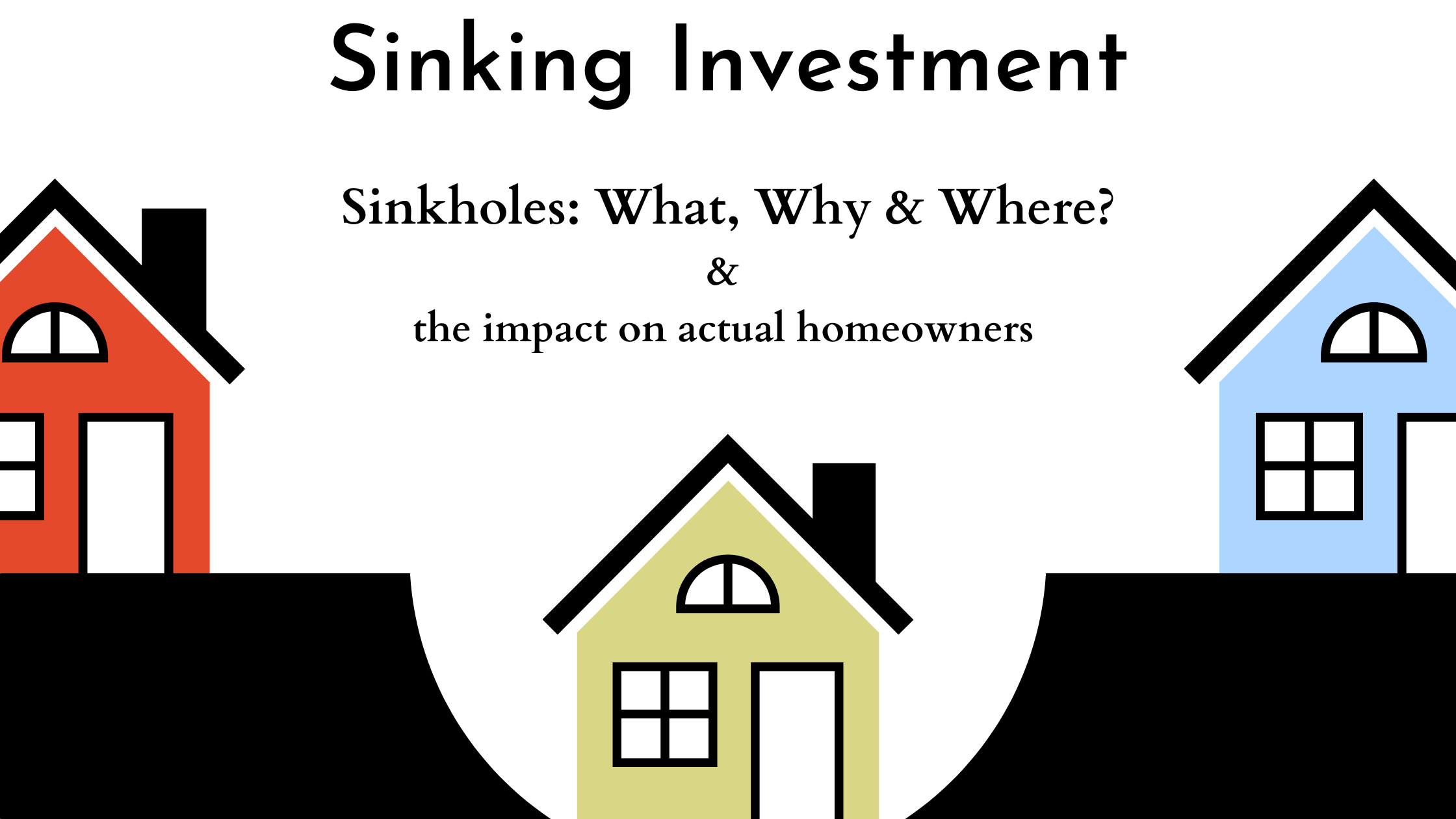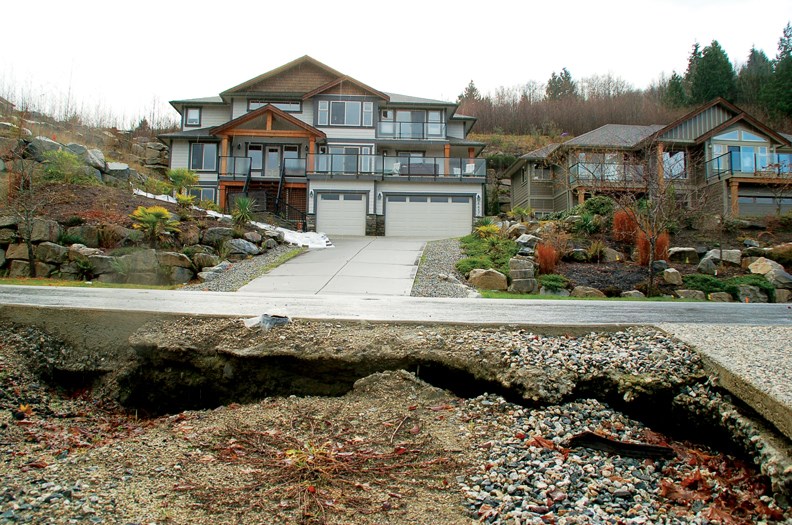 It’s every homeowner’s nightmare, their house crumbling away – but for some, this nightmare is their reality, as sinkholes swallow their homes.
It’s every homeowner’s nightmare, their house crumbling away – but for some, this nightmare is their reality, as sinkholes swallow their homes.  It’s every homeowner’s nightmare, their house crumbling away – but for some, this nightmare is their reality, as sinkholes swallow their homes.
It’s every homeowner’s nightmare, their house crumbling away – but for some, this nightmare is their reality, as sinkholes swallow their homes.
Sinkholes are holes in the ground that form when water dissolves the rock on the surface, resulting in a sinking of the ground. Although they can be naturally occurring, there are also actions taken that can cause them to develop, including:
There have been a few prevalent sinkhole subdivisions in the news in recent years. A few notable include. . .

In Canada, a developer bought a land parcel overlooking Snake Bay with a plan for a 28-lot neighborhood of luxury homes with stellar views. The city’s bylaws required geotechnical reports to be done – which obtain information on the physical properties of soil, to ensure it is viable for the plan.
In 2006, a report was issued by a geotechnical engineer for the site that documented sinkholes present and set forth a plan for safe construction. Due to this report, the city required that the developer register a restrictive covenant against the title on each of the lots, which would alert prospective buyers to the findings. However, buyers of the lots claimed that this important information was never provided to them at any point.
Then, in June 2012, the first major sinkhole occurs, and in 2015, one claims its first home. Eventually, on Christmas Day in 2018, another large sinkhole appears and the city performs a report, which proved that continued use of the site could be deadly. On February 7th, 2019, the city tells residents to evacuate the site or face removal.
The city reports spending $680,000 on ways to remedy the site. One of these reports estimated that a potential repair would cost upwards of $10 million, with no guarantee of success; the city did not move forward with any plan from these investigative efforts.
Three years after being forced to leave, the state of emergency was lifted; however, sinkholes were still a problem, and the value of the once million-dollar homes sat at $2, according to local assessments.
Now, the homes sit empty, slowly deteriorating with items destroyed or thrown around and the walls bearing graffiti; this video uploaded 9 months ago shows the current state of the neighborhood, homes, and sinkhole situation.
/cloudfront-us-east-1.images.arcpublishing.com/gray/N7BQOP45O5P23OVKM7U32IAFIQ.jpg?resize=640%2C360&ssl=1)
In April 2020, a sinkhole appeared in the Hideaway Hills neighborhood – swallowing up an entire front yard. Since then, the sinkhole has continued to grow, claiming other homes. The sinkhole’s existence stems from an underground mine, that has caused instability in the ground of the subdivision; this is because the mine was never closed properly and extends beyond its recorded limits. To fix the problem, the houses and infrastructure would have to be removed and the ground supported via filling or putting in supports – before rebuilding.
The photo below is part of the case, showing where the mining was occurring in comparison where the subdivision was built.

The sinkhole has caused structural problems to occur in the evacuated homes, like:
This has decimated property values and made homes unlivable, causing residents to have multiple home payments or face the difficult decision to face foreclosure.
In September 2022, a South Dakota judge granted the homeowners the ability to bring a class action lawsuit against the state. The suit claims that the state acted recklessly when it did not properly close the state-operated mine. The case is set to take time – if you’d like to follow along with updates, the case name is Andrew Morse and John and Emily Clarke et al. v. State of South Dakota et al.

In July 2017, a sinkhole formed and destroyed two homes; in the following days, five more became unsafe. Florida is a hot spot for sinkholes, due to the limestone in its soil composition – which is soluble. It’s such an issue that there is even an area coined “Sinkhole Alley” in central Florida.
Even during the cleanup, which ended up costing around 1.1 million dollars, the sinkhole continued to expand in diameter, by 25 feet.
The two main homes had sinkholes previously in 2012. These sinkholes were “remedied” through a process called grouting – where a dozen pipes or more are driven down into the soil with depths reaching 60 feet and then filled with concrete. Evidently, this remediation was not successful and led to an eventual failure that proved catastrophic.
It is unclear what happened next to remediate the situation this second time – there were talks of connecting it to a nearby lake, creating a turnaround for delivery trucks, and a few other options. As of now, the site appears fenced and vacant (from Google Maps).
No, sinkholes can be a problem anywhere – from roadways, to single homes, to fields. The sinkholes in subdivisions threaten more homeowners, which is why you may hear about them. Some recent sinkholes that have occurred outside of subdivisions include. . .
There are countless other sinkhole stories on the Internet and plenty more that never actually hit the news, due to their level of notability.
Well, luckily, sinkholes are unlikely to occur in Wisconsin based on the makeup and distribution of the bedrock; however, that’s not to say it can’t or won’t ever happen (as seen in the Hank Aaron State Trail).
Sinkholes can occur in any area that has krast, which is a landscape that occurs when water dissolves rocks. In Wisconsin, krast is most likely to be found in a “V-shaped swath from St. Croix County, along the Mississippi River across the bottom two tiers of counties, and northeast along Lake Michigan up to Marinette County.” So, if you’re looking to avoid sinkholes, you’ll want to avoid buying in a place with krast.
Although, even if you avoid krast, it doesn’t mean you will avoid sinkholes. Sinkholes can also be man-made, which make this variety more random and close to impossible to plan for.
If you feel like you’ve been hearing about more sinkholes lately, it’s probably because you are. They’re becoming more common and happening more often across the World – mostly due to human causes.
Human activities do have an impact on sinkholes – as it mostly relates to water, digging, or disturbance of an area. Human activities that lead to sinkhole development include. . .
As disruptive human activities have increased, there has been an increase in the occurrence of sinkholes.
Sinkholes are a nightmare resulting in high costs, crushed dreams, and lengthy lawsuits to try and find a responsible party. When purchasing homes, especially in areas with high frequencies of sinkholes, buyers must be aware of the potential for them to occur with no warning. In some areas, sinkhole insurance may be available to add to a home insurance policy.
Unfortunately, there are some things that are a part of home ownership and the potential for sinkholes is one of these things that owners need to be aware is a tragic possibility.